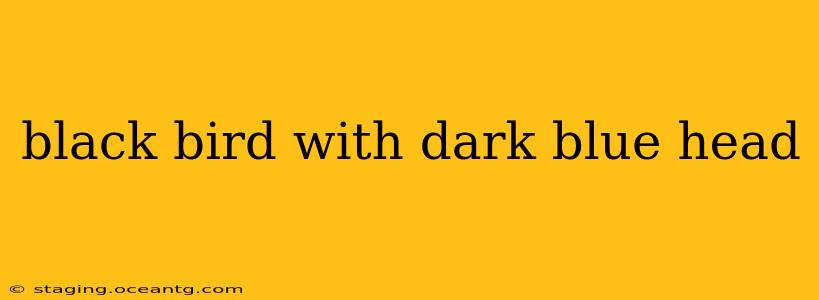Have you spotted a striking black bird with a dark blue head? This description could apply to several species, making identification a fascinating challenge. This guide will help you narrow down the possibilities, considering geographical location and key physical characteristics. Let's delve into the world of avian identification!
What kind of black bird has a dark blue head?
This is the most common question, and the answer depends heavily on your location. Several bird species boast a predominantly black body with a dark blue head. To help narrow it down, consider the following:
- Geographic Location: Where did you see the bird? Knowing the continent, country, and even region significantly helps in identification. A bird found in North America will be vastly different from one seen in Australia.
- Size: Was the bird large or small compared to other birds in the area? Size estimations can help eliminate certain species.
- Other Distinguishing Features: Did the bird have any other noticeable markings? Consider things like the color of its beak, the shape of its tail, any wing bars, or the overall shape of its body. Note any unique behaviors as well.
What are some common black birds with blue heads?
While a definitive answer requires more information, here are a few possibilities depending on location:
- The Eurasian Jay (Garrulus glandarius): While not entirely black, the Eurasian Jay has a striking black body with a dark blue head featuring white markings. This bird is found across Europe and Asia.
- Certain subspecies of the Common Grackle (Quiscalus quiscula): Some subspecies of Common Grackles have iridescent dark blue or purplish-blue heads. However, their bodies are more of a deep black, sometimes showing hints of green or bronze. They are found throughout North America.
- The Great-tailed Grackle (Quiscalus mexicanus): Similar to the Common Grackle, but with a significantly longer tail. Again, iridescence plays a part; the head often displays dark blue or purple hues. Found mainly in North and Central America.
Could it be a different color? Is it possible that the lighting affected the color I saw?
Yes, absolutely! Lighting conditions can drastically alter how we perceive bird colors. A bird that appears dark blue in low light might appear black or even purple in bright sunlight. Also, consider the possibility that the color you perceived as "dark blue" might be a very dark purple or even a deep indigo. Accurate identification often requires careful observation under various lighting conditions or photographic evidence.
How can I get a better identification of a black bird with a blue head?
To accurately identify your mystery bird, gather as much information as possible:
- Take a picture (or video): This is invaluable for later identification. Try to get clear shots from various angles.
- Note the location: Be as specific as possible. Include details like habitat (forest, field, urban area).
- Record observations: Size, beak shape, tail length, any unique behaviors, and surrounding birds can all help.
- Use bird identification apps or websites: Many excellent resources, like Merlin Bird ID, eBird, and others, use your location and physical descriptions to suggest possible matches.
- Seek help from local bird experts or birding groups: Sharing your photos and observations with experienced birders can significantly aid in identification.
What are some resources for identifying birds?
Several online resources can assist in bird identification. These include websites dedicated to birdwatching, apps that utilize image recognition, and even online forums where you can post your pictures and get help from experienced birders.
By carefully considering these factors and utilizing available resources, you'll be well on your way to identifying that striking black bird with the dark blue head. Happy birding!
